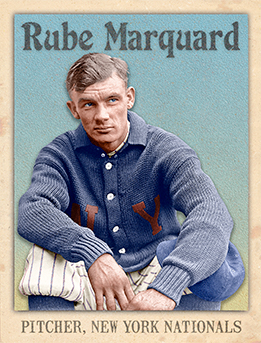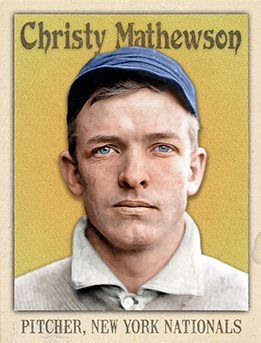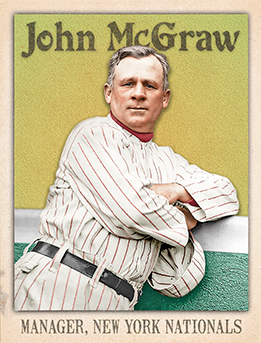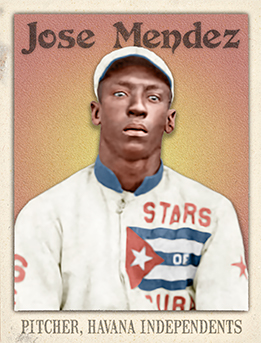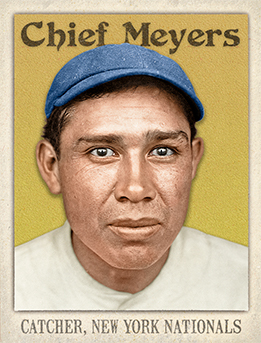- Series: Diamond Heads '15
- City: Philadelphia
- Team: Athletics (AL)
- League: American League
- Hall: National Baseball Hall of Fame
Cornelius McGillicuddy, Sr. (1862-1956). An average catcher with strong leadership skills for 11 professional seasons (1886-1896), Mack then owned (1901-1954) and managed (1901-1950) the Philadelphia Athletics for half a century, establishing many managerial records and a unique place in the pantheon of baseball icons in the 20th century.
- 5x World Series Champion
- Most Managerial Wins: 3,731
- Most Managerial Losses: 3,948
- Elected to Hall of Fame: 1937

- Series: Diamond Heads '15
- City: Philadelphia
- Team: Phillies
- League: National League
Sherwood Robert Magee (1884-1929) was a brawling rogue and one of the best outfielders in Philadelphia history. Fans with long memories smiled when this man who had once been suspended for cold-cocking an ump turned to officiating games upon his retirement as a player. Magee began a decade-long streak as the Phillies’ left fielder as a 19-year-old rookie. He had great years at the plate but none better than in 1910, the year before he knocked out Bill Finneran and suffered the worst sanction dealt by the NL since 1877. In ’10 Sherry bested even Honus Wagner, winning the NL batting title and leading in runs and RBI.
- Magee played minor league ball until age 40, then turned to umpiring. The NL put him under close watch due to his prior history but he established himself as a fine arbiter
- Struck down by pneumonia at 44, Magee was lauded in the press as “one of baseball’s most colorful figures,” and “one of the greatest natural batsmen in the game”

- Series: Diamond Heads '15
- City: Boston
- Team: Braves
- League: National League
- Hall: National Baseball Hall of Fame
Walter James Vincent Maranville (1891-1954) played 23 ML seasons as a madcap shortstop, catching pop-ups like a circus performer and hitting in the clutch often enough to make the Hall of Fame with a .258 lifetime average. Along the way, “Rabbit” became the smallest 20th Century inductee and the only one to be demoted to the minors mid-career. His endurance and eventual recognition among the pantheon of the sport are tributes to his effervescent spirit and dogged work habits. He partied as hard as he worked, witnessed by his pivotal HR on 8/6/14 that sparked the Boston Braves’ “miracle” comeback to take the pennant and Series — he never saw Babe Adams’ pitch. He was way too hung over. A broken ankle in an exhibition game with the Yankees effectively ended his long career in 1934.
- In retirement, Rabbit mentored many young players in NY, including Whitey Ford & Billy Loes
- His record of most MLB seasons wasn’t eclipsed until Pete Rose in 1986
- Elected to Hall of Fame: 1954
- Series: Diamond Heads '15
- City: New York
- Team: Giants
- League: National League
- Hall: National Baseball Hall of Fame
Richard William Marquard (1886-1980) was a dominant left-hander with the Giants, Robins, Reds and Braves from 1908-25. His Hall of Fame plaque highlights his outstanding performance for NY’s consecutive titles 1911-13 with 23+ wins each year and a record 19 in a row. This streak vindicated the outlandish $11K price the Giants paid to get him from the American Assoc.
- The nickname wasn’t a “bumpkin” reference but a comparison to Waddell
- Helped Brooklyn to pennants in 1916 & 1920
- Elected to Hall of Fame: 1971

- Series: Diamond Heads '15
- City: St. Louis
- Team: Terriers
- League: American League, Federal League
- Hall: Cuban Baseball Hall of Fame
Armando Marsans (1887-1960) was the first Cuban to make a real impact in the major leagues. Frank Bancroft had spotted Marsans and Rafael Almeida in exhibition games in 1905 and finally brought them to Cincinnati in 1911. In his sophomore season with the Reds, Marsans hit .318 with 35 stolen bases and only 17 strikeouts in 448 plate appearances, placing a respectable 18th in Chalmer’s Award voting for 1912. A row with fiery manager Buck Herzog resulted in Marsans seeking a job with the new Federal League’s St. Louis Terriers in ‘14. When the league folded, Marsans signed on with the Browns but inactivity took a toll. Two years with the Yankees ended his MLB career in 1918 but Armando had many more years of baseball left. He continued to play winter ball back home through the 1928 season and became the first to play in the majors and the Negro Leagues in 1923 with the Cuban Stars. Marsans thrived as a manager in both Cuba and the States (another first for his countrymen), finally retiring in 1947 after 43 years in baseball.
- The blue-blood Marsans was well-educated and an entrepreneur as well as a savvy baseball mind. Nevertheless, the Reds fended off race-baiting accusations in 1911
- Artist’s Note: Images of Marsans are fairly rare and it is not uncommon for me to take liberties with dates and uniforms. This photo was taken in 1916 when Marsans was with the St. Louis Browns. In anticipation of the feedback I will receive, I’d like to invite you to join me in pretending this is a St. Louis Terriers’ uniform. Cheers!
- Elected to Cuban Baseball Hall of Fame in its inaugural class: 1939
- Series: Diamond Heads '15
- City: New York
- Team: Giants
- League: National League
- Hall: National Baseball Hall of Fame
Christopher Mathewson (1880-1925) was the consummate right hander of the early 20th Century. His “fadeaway” pitch baffled NL hitters from 1900-16. Mathewson won 22+ 12 straight years, 30+ 4x, and holds the modern NL record with his 37 wins in 1908. He hurled 3 shut-outs in 6 days to gain his sole world championship in 1905.
- One of the “first five” into Cooperstown
- Accomplished all this while honoring his Christian faith by not pitching on Sundays
- Elected to Hall of Fame: 1936
- Series: Diamond Heads '15
- City: New York
- Team: Giants
- League: National League
- Hall: National Baseball Hall of Fame
John Joseph McGraw (1873-1934) was an innovative player (the hit-and-run, the “Baltimore chop”) but went on to true greatness as a manager for Baltimore and, most noteworthy, the NY Giants. Only Connie Mack’s teams won more games and no NL manager approached him. Not shabby as a hitter (ranks 3rd all time behind Ted Williams and Babe Ruth in OBP), has been called “the best player to become a great manager.”
- Played for and/or managed ten NL pennant winners
- Upon his death, McGraw’s wife discovered a list of all the African-American players he wanted to sign but was prevented
- Elected to Hall of Fame: 1937
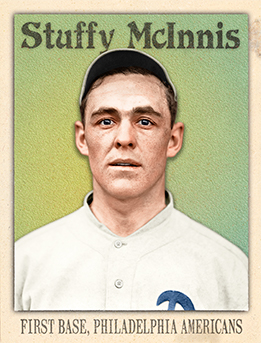
- Series: Diamond Heads '15
- City: Philadelphia
- Team: Athletics (AL)
- League: American League
John Phalen McInnis (1890-1960) helped five teams to world championships as a stellar first baseman. He broke in with the Athletics in 1909 and soon became part of the elite “$100,000 Infield” with Eddie Collins, Frank Baker and Jack Barry. That team won four AL pennants in five years with three titles before losing to the Miracle Braves in their incredible 1914 sweep. Federal League incursions prompted Connie Mack to break up his famed nine but kept Stuffy through the 1917 season. A great batting eye made McInnis one of the toughest to fan (he struck out a mere 189 times in 7822 career at-bats.) and he compiled a .307 lifetime average. Equally adept afield, Stuffy was a perennial defensive leader at first. In 1921 he made one error in 1651 attempts. His Red Sox record was not exceeded until Kevin Youkilis played 120 error-free games in 2007. McInnis would play for the Indians, Braves, Pirates and Phillies, wrapping his long and distinguished career as player-manager in Philadelphia in 1927.
- His skill at the plate enabled McInnis to accomplish 384 sacrifice hits, the third-best in MLB history
- After his career in the majors, Stuffy coached college squads ending with the Harvard Crimson from 1949-54
- Series: Diamond Heads '15
- City: Indianapolis
- Team: Hoosiers (FL)
- League: Federal League
- Hall: National Baseball Hall of Fame
William Boyd McKechnie (1886-1965) was a noted baseball strategist and the only manager to lead three teams to NL pennants. Won World Series titles with two clubs: the ’25 Pirates and ’40 Reds. A player, manager and then coach for nearly half a century, “the Deacon” was known for his temperance and piety.
- Served as coach for young Indians manager, Lou Boudreau, winning the ’48 Series
- Elected to Hall of Fame: 1962
- Series: Diamond Heads '15
- City: Havana
- Team: Stars of Cuba
- League: Independent
- Hall: Cuban Baseball Hall of Fame, National Baseball Hall of Fame
Jose de la Caridad Mendez (1887-1928) visited America from his native Cuba in 1908 and demolished the ML Cincinnati Reds and minor league all-stars from Florida. He was unbeaten, untied, and unscored upon. He allowed but a single to Miller Huggins in the 9th inning of his first game on US soil, and hurled a no-hitter in Key West. Ira Thomas, catcher for the 2-time world champion Athletics, compared Mendez favorably to Walter Johnson and said “he is a remarkable pitcher, and if he were a white man would command a good position on any Major League club in the circuits.”
- Became a star in the Negro Leagues, leading the KC Monarchs to pennants in ’23, ’24, and ‘25
- The Cuban “Black Diamond’s” career spanned 1908-26
- Elected to the Cuban Baseball Hall of Fame in its inaugural class: 1939
- Elected to the National Baseball Hall of Fame: 2006
- Series: Diamond Heads '15
- City: New York
- Team: Giants
- League: National League
John Tortes Meyers (1880-1971, a Native American in a benighted era, “Chief” faced many hurdles in becoming perhaps the best hitting catcher of his day. Literate, poised and good-humored, Meyers gained fame as battery-mate to Christy Mathewson, hitting over .300 for 3 consecutive Giants pennants, 1911-13.
- Toured the vaudeville circuit occasionally in an act with Mathewson they called “Curves”
- Hit .358 in 1912 and was third in the MVP balloting
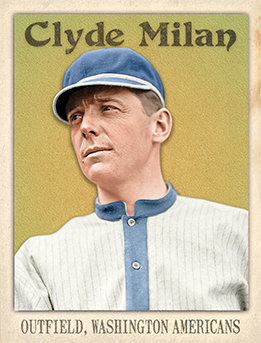
- Series: Diamond Heads '15
- City: Washington, D.C.
- Team: Senators
- League: American League
Jesse Clyde Milan (1887-1953) spent most of the first half of the 20th century as a Senator. He was a steady outfielder and renowned base stealer from 1907-1922. After brief stints in the minors, Milan returned to scout and coach for the team until stricken on the field in spring training. Over his 16 seasons Clyde hit .285 and stole nearly 500 bases. His 88 steals in 1912 stood as the ML record until Ty Cobb swiped 96 in ‘15. Clark Griffith considered Milan the franchise’s greatest centerfielder whose speed allowed him to play more shallow than any in the game. Clyde was lured to D.C. by a $1000 bonus, joining fellow rookie Walter Johnson who signed for a hundred bucks. The two became fast friends and the best players on the roster. Griffith tried to make a manager of Milan in 1922 but he didn’t have the stomach for the job. Ulcers drove Clyde to the minors for several years before rejoining his beloved Senators.
- For two seasons, Milan was a teammate of brother Horace: 1915 and ‘17
- Only 167 players spent their entire career with one team. Milan’s tenure in Washington ranks him in the upper fourth of those stalwarts

- Series: Diamond Heads '15
- City: St. Louis
- Team: Cardinals
- League: National League
John Barney Miller (1886-1923) broke into major league ball in 1909 at the top of the game. As second-baseman for the Pirates, Dots would spend his rookie season with a champion as Pittsburgh won the NL pennant and beat the Tigers in the World Series. Miller went on to a fine 12-year career with three National League clubs: five with Pittsburgh, five with the Cardinals and the last two with the Phillies. When Fred Clarke brought Miller to the ‘09 spring camp he played him at short as the team’s regular, a guy named Honus Wagner, was late arriving. There was no way Miller would stay at that position once Wagner finally showed up but his play impressed Clarke enough to earn a spot at 2nd. A reporter asked Wagner who the new kid was and Hans said “That’s Miller.” The scribe noted it phonetically and a memorable nickname was born. Dots became a versatile addition to each team, playing every position for St Louis and prompting Ring Lardner to dub him the best utility man of the era.
- Miller succumbed to TB just as his promising managerial career was beginning. He led his San Francisco Seals to the PCL pennant in 1922
- NL president John Heydler paid tribute to “a brainy player, well liked everywhere…”



